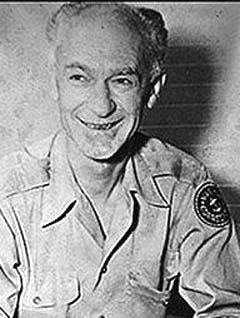PYLE-ERNEST
ERNEST TAYLOR "ERNIE" PYLE

S3

POPULAR WWII WAR CORRESPONDENT
Ernest Taylor Pyle was a Pulitzer prize winner and widely known American journalist during World War II, popularly known as Ernie Pyle. He was born on August 3, 1900, near Dana, Indiana, and after attending local schools, he joined the Naval Reserve during World War One in October 1918 at the age of 17. He served three months of active duty aboard the gunboat/training ship USS WILMETTE (GX-13) until the war ended, then finished his enlistment in the reserve until he was discharged in September 1921 with the rank of Petty Officer Third Class.
After the war, Pyle attended Indiana University until leaving, with only a semester left, to accept a job as a reporter with the The Washington Daily News. In 1926, tired of working at a desk, Pyle quit his job and for the following two years traveled across the United States. In 1928 he returned to The Washington Daily News where he became known as the country’s first and best-known aviation columnist. During the following years Pyle became well known as the author of a national column as he wrote for the Scripps-Howard Alliance about the unusual places and people he met traveling the highways and back roads of the country.
Shortly after the United States entered World War II in 1941, Pyle became a war correspondent and applied his intimate style to combat reporting as he wrote from the perspective of the common soldier and their life which consisted wholly and solely of war from the view of front-line infantrymen. During the war in Europe, Pyle was frequently with front line troops in North Africa and Italy, and then covered the Allied landing at Normandy on D-Day. In July 1944, Pyle was almost killed in an accidental bombing by the U.S. Air Force near Stint-Lo, France.
After a period of hospitalization in the U.S. for “war neurosis,” Pyle next began covering the war in the Pacific. On April 17, 1945, Pyle came ashore with the Army’s 305th Infantry Regiment of the 77th Division on Le Shima, a small island northwest of Okinawa. The following day, while traveling with troops in a jeep they encountered enemy machine gun fire and immediately took cover in a nearby ditch. A short time later Pyle raised up to look around and another gun burst struck him in the left temple just under his helmet, killing him instantly. Pyle was buried with his helmet on, among other battle casualties, with an infantry private on one side and a combat engineer on the other. The men of the Army unit he was covering erected a monument, which still stands, at the site of his death. Its inscription reads, “At this spot the 77th Infantry Division lost a buddy. Ernie Pyle, 18 April 1945.” The following day, Eleanor Roosevelt wrote, “How much I admired this frail and modest man who could endure hardships because he loved his job and our men.” In 1983, Pyle was awarded the Purple Heart, a rare honor for a civilian, by the 77th Army Reserve Command.
After the war, Pyle’s remains were re-interred at the Army cemetery on Okinawa, and later to the National Memorial Cemetery of the Pacific in Honolulu, where his memorial marker carries the inscription: US NAVY – WORLD WAR I – PURPLE HEART. Numerous tributes in honor of Ernie Pyle have been named since his death. Among them, at Indiana University, the School of Journalism has a bronze statue of Pyle, is housed in Ernie Pyle Hall, and scholarships are given to students with a military service record and an ability in journalism; Pyle’s last home in Albuquerque, New Mexico, was adapted as the first branch library; the Ernie Pyle State Historic Site in Dana includes his boyhood fully restored farmhouse containing many army artifacts; in 1971 a U.S. postage stamp was issued; elementary schools are named after him in Indiana, California and New Mexico; in 1945, employees of Boeing-Wichita paid for and build a Boeing B-29 Superfortress which flew with the U.S. Air Force until 1953. In addition, on June 25, 1945, the military cargo ship SS ERNIE PYLE was launched and was operated by the U.S. Maritime Commission. The writer, then a Yeoman Second Class, was fortunate to be a passenger aboard SS ERNIE PYLE on its maiden voyage when it left San Francisco on November 1, 1945, carrying occupation troops to Yokohama, Japan. SS ERNIE PYLE continued as a transport ship carrying troops, displaced persons and refugees until 1949.
In February 1945, Ernie Pyle was a passenger aboard the carrier USS Cabot (CV-28) and wrote the following:
“An aircraft carrier is a noble thing. It lacks almost everything that seems to denote nobility, yet deep nobility is there. A carrier has no poise. It is top-heavy and lopsided. It has the lines of a well-fed cow. It doesn’t cut through the water like a cruiser, knifing romantically along. It doesn’t dance and cavort like a destroyer. It just plows. You feel it should be carrying a hod. Yet a carrier is a ferocious thing, and out of its heritage of action has grown its nobility. I believe that every Navy in the world has as its number one priority the destruction of enemy carriers. That’s a precarious honor, but it’s a proud one.”
Submitted by CDR Roy A. Mosteller, USNR (Ret)

